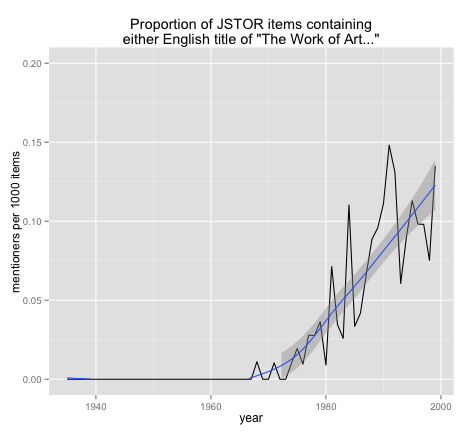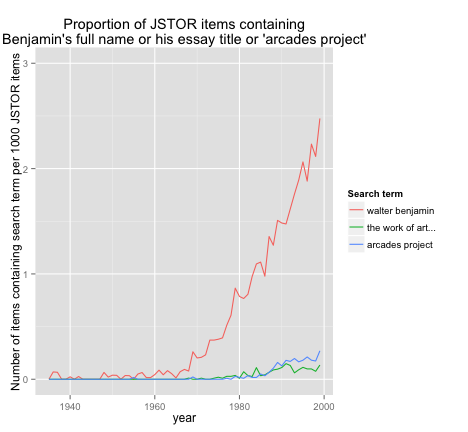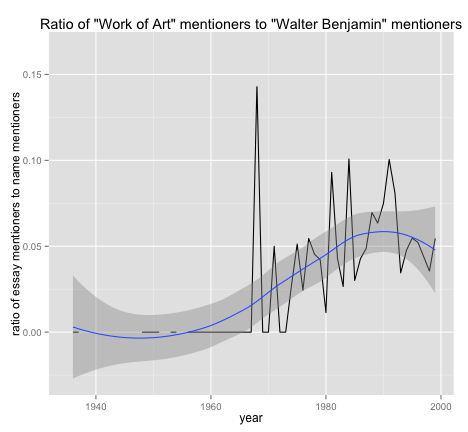Does Art That Is Mechanically Reproduced Still Have an Aura? if So Why? If Not Why? Quizlet
This post could also exist chosen: Walter Benjamin in the Age of Me Noodling Around with Small Information.
On Monday I participated in a roundtable discussing Walter Benjamin's essay "The Piece of work of Fine art in the Age of Its Technological Reproducibility"/"The Work of Art in the Age of Mechanical Reproduction." Rereading this essay after non having looked at information technology in five years or so, I was struck past the degree to which Benjamin anticipated (or, better, laid the groundwork for) both the rhetoric and the analytic procedures of contemporary historicist literary criticism and cultural studies: analogous large social-structural changes with changes in artistic genres and artistic values;attending to popular culture aslope high culture; and, specially, announcing the imperative to "politicize fine art." This is non quite as banal as might seem—after all, Benjamin was not an bookish, and this famous essay is not a work of literary criticism or of philology. Anyway it made me desire to think more than well-nigh the reception history of this essay.
I had wanted to bring to that roundtable a couple of quick factoids from that reception history using JSTOR's archive of scholarly journals. I didn't quite manage the nice handout I envisioned, but every bit I put together my remarks I gathered a little data, so this post relates the explorations I made.
Using the JSTOR Data for Inquiry interface, I downloaded metadata for all JSTOR items (articles, book reviews, etc.) that included one of the following strings (instance-insensitive):
- walter benjamin
- work of art in the age of its technological reproducibility
- work of art in the age of mechanical reproduction
With the assistance of scripts I'd developed before, I compared the frequency of items with these strings in them over time. (Northward.B. None of these search strings is a perfect indicator of the entity it appears to refer to. Benjamin is often called just "Benjamin," merely automatically disambiguating the Benjamin from all the Benjamins of the globe is no uncomplicated task. And the two essay titles, because they are composed of many tokens, have, I'd assume, a higher probability of beingness distorted by OCR errors as well equally a lower "natural" [Zipf'south police force] probability of occurrence.)
Here are the totals:
- walter benjamin all items: 8200; manufactures: 5006
- work of art in the age of mechanical reproduction all items: 410; articles: 353
- work of art in the age of its technological reproducibility all items: 111; articles: 97
Equally information technology turns out, the alternate essay titles are co-mentioned in but a handful of items, and so the full number of mentions of either English title is
Either English title of "The Work of Art..." all items: 517; manufactures: 447
The sheer number of these mentions (and their steady increase over time, equally we'll see below) gives an indication that Benjamin'due south essay is canonical for scholarship, a recurrent point of reference. To appreciate what this means qualitatively, you could notice that in the essay'south latest English language version, at the caput of a volume of selected writings on media, the first mention of Marx receives an explanatory note (Walter Benjamin, "The Work of Art in the Age of Its Technological Reproducibility," in The Work of Art in the Age of Its Technological Reproducibility, and Other Writings on Media [Cambridge: Harvard, 2008], 43n. 2). But you could also track the essay'due south standing rise in mentions over time:

(I accept divided each yearly count by the total number of items in JSTOR for that year, which of course too increases with time, to give a sense of the essay's increasing share of attending.)
It is also continuously important though not dominant in the reception of Benjamin'south œuvre, which we can see by comparison the frequency of items mentioning "Walter Benjamin" to those mentioning his essay:

Some other fashion to do this comparison is to wait at the ratio of these two frequencies with a smoothing line added:

Though "The Work of Fine art" is of import in Benjamin's reception, The Arcades Project has caught up over time:

Nonetheless, there is one "Work of Art" -mentioner for every 10 to 20 "Walter Benjamin"-mentioners in well-nigh years from 1970 onwards. That strikes me as a adequately substantial representation in Benjamin-reception for a single short essay known best as part of Illuminations.
For comparison, I chose more or less at random another critical chestnut of "theory" from roughly the same period, "The Intentional Fallacy." Though items mentioning "intentional fallacy" are about ten times more frequent than items with "work of art in the historic period of mechanical reproduction," this term does not evidence the upward trend of Benjamin'due south works in JSTOR:

Thus this preliminary analysis indicates the scope of Benjamin's influence in the journals archived by JSTOR, and the prominence of "The Work of Art" within it.
So far, so simple, yet there is a not-Benjaminian lesson to draw hither, I think. The reception of Benjamin'southward piece of work tells a different story about culture in the "age of technical reproducibility" than the essay itself does. Benjamin's essay posits a transformation in the nature of the artwork resulting from the conditions of technical reproducibility. For Benjamin, this transformation entails at least two things. First, the decay of aura, which, he claims, eliminates "all semblance of art'southward autonomy" (28). 2d, the opportunity for revolutionary intellectuals to "politicize art," dialectically reversing fascism's aestheticization of politics (42). I believe the appeal of these ii moves in literary studies since the 1970s has had to do with their overestimation of the power of the individual critical-interpretive act. Benjamin performs a stunning spring from noting a broad (and dubious: every bit anybody knows, impress reproducibility is not a nineteenth-century innovation) technological transformation to a claim about changing cultural values; this aforementioned leap allows him to merits political urgency for a discussion of aesthetics. And this gesture of politicizing fine art has go familiar, even ritualized, in literary and cultural criticism.
What has dropped out of the picture is precisely the long chain of mediating processes betwixt the technologies of cultural reproduction and the many domains of values and judgments (artful, cultural, political…). What kind of mediating processes? Processes like (in the case of texts) publishing and republishing, reviewing, canonization, re-reading, critical appreciation and appropriation. These are not processes of re-production except in a very broad sense. They are, rather, processes of cultural production (of meanings, of further texts, of condition, even of…the "semblance of [relative] autonomy"). To follow Benjamin's emphasis on reproducibility and its relation to the singular artwork is to obscure an as consequential transformation: the final century's massive increase in the number and multifariousness of cultural products. At that place are more than and more than photographs, songs, novels…and scholarly manufactures. (Flick production does not increase as dramatically, however.) the world of scholarship does witnesses this increase:

There are hundreds of scholarly responses to "The Work of Art…," thousands of scholarly texts that mention Benjamin'south name in JSTOR-digitized print. This is not an account of the work of art in the age of mechanical reproduction. It is "The Work of Art" in the age of technically facilitated cultural production on an unprecedented and ever-increasing scale.
Source: https://arcade.stanford.edu/blogs/benjamins-work-art-age-production
0 Response to "Does Art That Is Mechanically Reproduced Still Have an Aura? if So Why? If Not Why? Quizlet"
Post a Comment